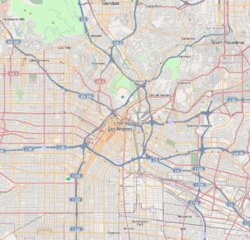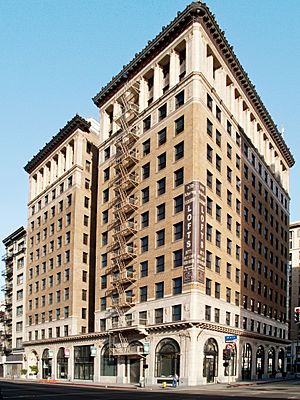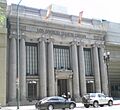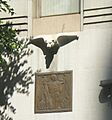Spring Street (Los Angeles) facts for kids
Quick facts for kids |
|
|
Spring Street Financial District
|
|
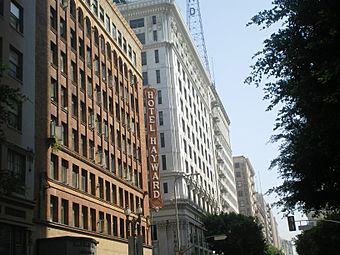
Spring Street looking north from Hotel Hayward
|
|
| Location | 354–704 S. Spring St., Los Angeles, California |
|---|---|
| Built | 1902 |
| Architect | Morgan, Walls & Morgan; Parkinson, John |
| Architectural style | Chicago, Classical Revival, Moderne |
| NRHP reference No. | 79000489 |
| Added to NRHP | August 10, 1979 |
Spring Street in Los Angeles is one of the city's oldest streets. It was originally called Calle Primavera, which means "Spring Street" in Spanish. In Downtown Los Angeles, a special part of Spring Street is known as the Spring Street Financial District. This area is famous for its beautiful buildings and was once called the "Wall Street of the West." It's part of the Historic Core district downtown.
Contents
What is the Spring Street Financial District?
This historic area includes 23 buildings that were once banks or financial offices. It also has three hotels. These buildings are located along South Spring Street, between Fourth Street and Seventh Street. In the early 1900s, this part of Spring Street was the main financial hub of Los Angeles. Many important banks and financial companies were located here.
A famous architect named John Parkinson designed many of these buildings. He also designed other well-known Los Angeles landmarks. These include the Los Angeles Memorial Coliseum, Los Angeles City Hall, and Union Station. Ten buildings in the district are even recognized as Historic-Cultural Monuments. This means they are very important to the city's history and culture.
The Spring Street Financial District was added to the National Register of Historic Places in 1979. This is because so many historic bank and financial buildings are still standing there. You can even take walking tours of the district to learn more about its history and architecture.
How did Spring Street become famous?
Early Beginnings
In the 1880s and 1890s, the main business area of Los Angeles was further north. It was near South Spring and Temple Streets.
Spring Street also has a cool connection to the movie business. In 1898, Thomas Edison filmed a short movie here. It was called "South Spring Street Los Angeles California." He used a giant camera on a wagon to capture the busy street.
"Wall Street of the West"
In the early 1900s, the city center started to grow south. Banks and financial companies began to move to South Spring Street. The Continental Building was one of the first big buildings to move here. It was even considered the city's first skyscraper!
In 1911, the Los Angeles Times newspaper wrote about how fast buildings were being built on Spring Street. They said Los Angeles was building more than many other big cities. The building boom continued into the 1920s as Los Angeles grew. South Spring Street remained the city's financial heart even after World War II.
Changes and Comeback
In the 1960s, many banks started moving to other parts of downtown. By the 1980s, Spring Street looked very different. Many office buildings were empty.
But since the 1980s, people have worked to make Spring Street great again. Many art galleries have opened in the old financial district. This area is now sometimes called Gallery Row. Also, many old bank buildings have been turned into cool apartments called lofts. As new residents moved in, the area became more lively.
Beautiful Architecture
One of the best things about the Spring Street Financial District is its amazing architecture. Many of the buildings have a style called Beaux Arts. Their fronts are still almost exactly as they were built. This makes the district a popular place for movies and TV shows to film. They use the street to show what old city scenes looked like.
In 1985, a writer named Jack Smith said that Spring Street proved Los Angeles was not a "cultural wasteland." He called the financial buildings "palaces" and praised their "beauty, strength, unity and dignity."
Important Buildings on Spring Street
Here are some notable buildings in the district, from north to south:
The 12-story building at 810 S. Spring St. was built in 1924. It was designed by Walker & Eisen for the National City Bank of Los Angeles. In 2007, it became a Historic Cultural Landmark. It was later changed from offices into apartments and shops. It is now called the National City Tower.
Images for kids


